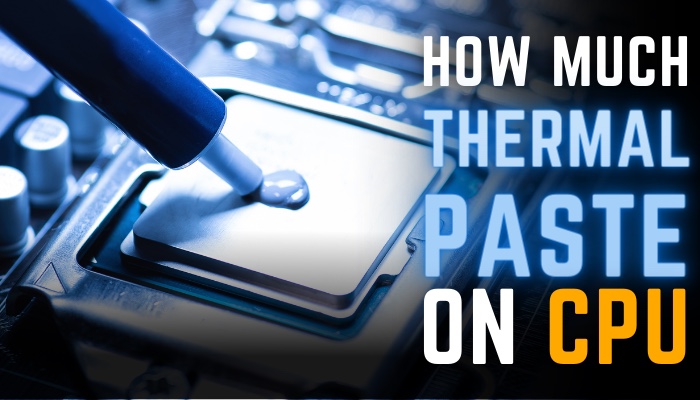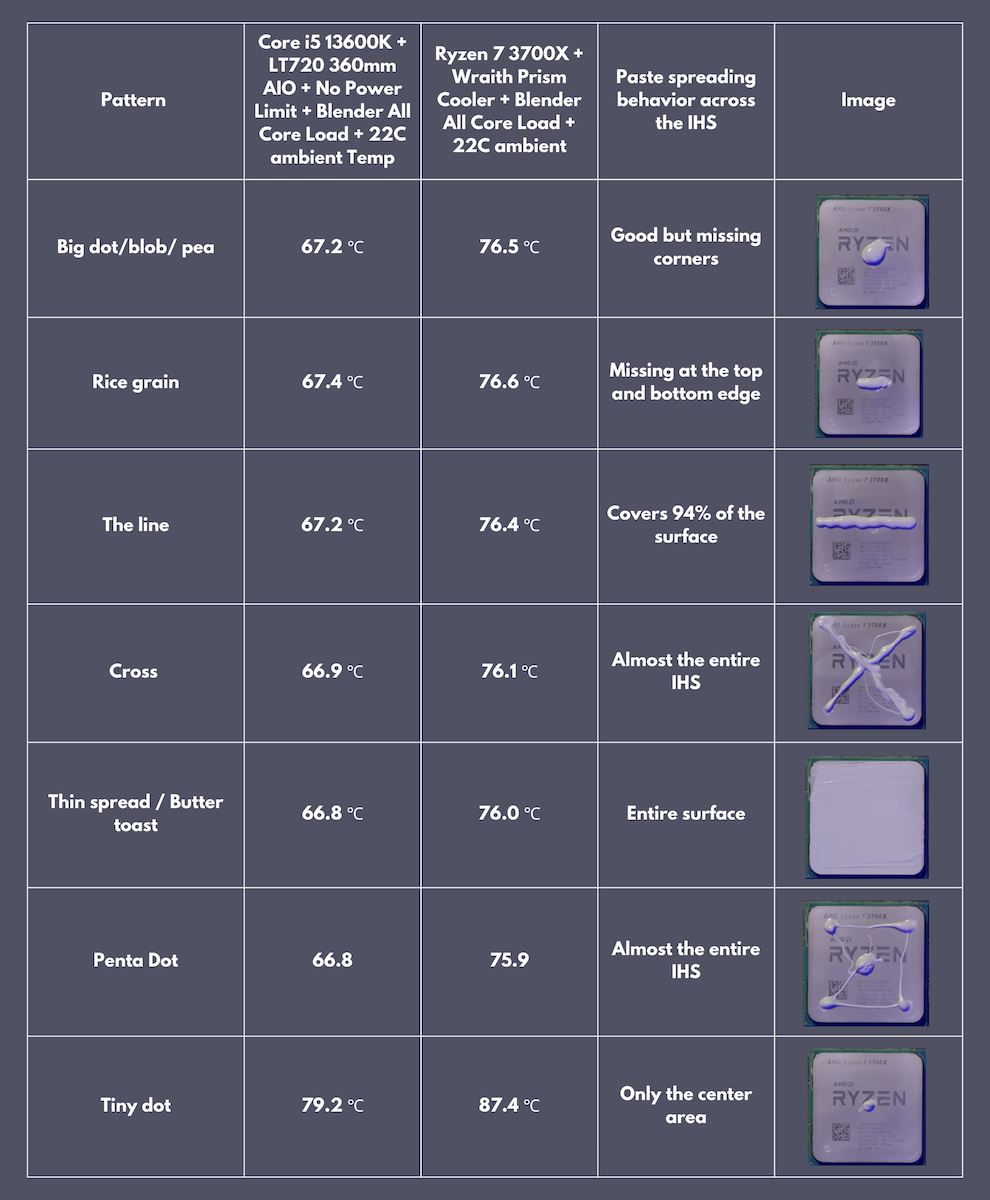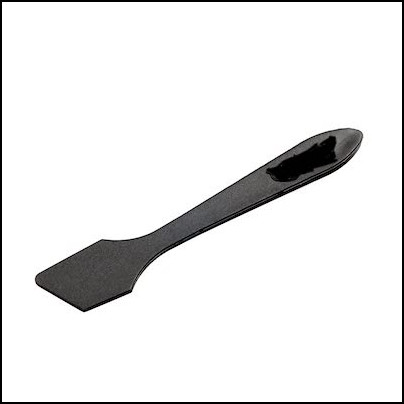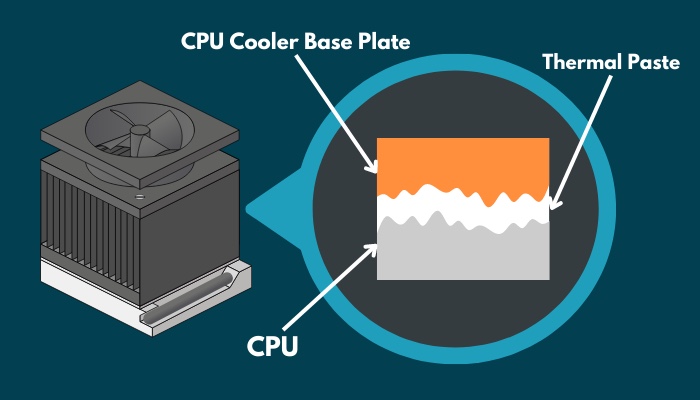I bet if you wander the PC building web verse to seek what is the right amount of thermal paste to use on your CPU, you’ll start questioning your life choices — Why did I even bother?
Trust me, you’ll witness tech Nazis spitting out theories on why you should apply the paste in a blob, pea, thin spread, and other shapes on your processor.
So, which one is the correct way, then? Let’s sort it out once and for all.
How Much Thermal Paste Should You Apply on CPU
You can apply thermal paste on the CPU following a dot or big blob, rice grain, butter toast or spread, penta dots, the line, and cross pattern. These shapes ensure great heat transfer from the IHS to the cooler’s cold plate. CPUs with Larger IHS, however, require a bit more paste than usual.
But how can I come to this conclusion? Well, I’ve tested extensively with all the common and popular patterns of thermal paste application.
I’ve conducted two tests, one with a multi-die chip Ryzen 7 3700X and another with a monolithic die Core i5 13600K.
For the AMD test bench, I’ve used the stock Wraith Prism cooler and DeepCool LT720 360mm for Intel.
Check out the final results, it’ll surprise you.
 As you can see, the temperature delta among different thermal paste application methods is between 0.4-0.6℃. Which falls within the margin of error.
As you can see, the temperature delta among different thermal paste application methods is between 0.4-0.6℃. Which falls within the margin of error.
So, you really don’t have to stress too much about which way you go. You’re mostly fine. But make sure to put enough amount so that the paste can spread and cover the die area. Otherwise, there’ll be heating issues, as you can see with the tiny dot method.
Now, there’s one more thing — if you apply too much paste, the leftover will escape to the edge and mess up the surroundings of the socket. Besides, if it enters inside the socket somehow, you may have a black screen and no post.
Not to mention, too much paste increases the distance between the IHS and the cooler’s heat transfer plate. As a result, cooling will be a bit worse. Not to a deal-breaking degree, by the way.
With that being said, for processors with greater IHS such as AMD Threadripper or Intel Xeon, make sure you put a little extra to cover up the entire surface.
Last but not least, some people just get too obsessed with the paste amount and calculate it in grams or milliliters to find the sweet spot. I find that ridiculous!
Just follow your intuition. No worries, nothing will break!
How to Apply Thermal Paste on Processors
As we’ve discussed in the previous section, you already know which way you can apply thermal paste on your CPU.
Make your mind on your paste application pattern whether it be a blob, thin spread, or cross, and start moving on by first installing the CPU in the socket. If you are, however, changing the paste, remove the cooler; clean off the thermal paste from the processor IHS thoroughly as well as the cooler plate.
Check the paste amount and ensure it meets the minimum threshold. If you wish to spread it throughout, do not use your finger. Get a thermal paste applicator instead.
In case the thermal paste sticks with the pins, it can damage your processor and motherboard. So, make sure to apply it carefully. And even if it sticks, clean the thermal paste off the CPU pins to secure the component.
Why Is Thermal Paste Important?
Thermal paste is applied to fill up the microscopic gap between the Integrated Heat Spreader (IHS) and the cooler’s contact plate. Due to the machined finish on the metal, there always exist some gaps and teeny-weeny irregularity on the surface area.
Gladly, thermal paste fills up the unevenness and makes perfect contact to disperse heat.
See, both surfaces are commonly made of copper, nickel, or other heat-dissipating metals. Unlike electricity, to conduct heat efficiently from one metal surface to another, there must be a singular continuous path.
The irregularities, however, trap air in between the contact area and produces air pockets. As a result, the passing of the heat is hindered big time. Not to mention, you’ll see the CPU hitting TJmax instantly when it is put to work.
When the thermal paste is applied, intermittent air obstructions and imperfect contact is gone. And so the two metal plate acts as a seamless heat conductor.
For this reason, thermal paste application is mandatory on a CPU.
That being said, I suggest not getting too adventurous and trying to run the CPU without thermal paste.
How Often Should You Replace Thermal Paste?
You should replace the thermal paste once a year. Though, the paste can last up to 2 or 3 years, depending on its quality. Not to mention, every time you remove the heat sink, and install a new cooler or a CPU, you must apply new paste.
Though it’s essential for the processor, extra thermal paste can potentially damage your CPU.
You know, there are diverse choices of thermal pastes in the market. Pick one from a reputed brand with a higher Watts Per Meter Square (W/mK) rating. It, typically, suggests how much heat it is able to pass from a square meter surface area.
FAQs
Is 4g of Thermal Paste Enough?
Yes, 4g of thermal paste is enough to use for multiple applications on a CPU or GPU. It is quite a lot. The application between the CPU or GPU and the heat sink requires a tiny amount of paste in general.
Does Thermal Paste Expire?
Yes, the thermal paste can expire. Depending on the quality, it can lose its heat conductive property in about 6 months to 2 years of time.
Ending Remarks
The debate on the amount of thermal paste application is an everlasting one. There are a thousand pundits, divided into sects and groups, to prove that their way is the correct one. But in reality, it really doesn’t matter, as long as you cover up the IHS and coolers contact plate correctly.
For further queries, comment below. See you at the next one. Peace!




